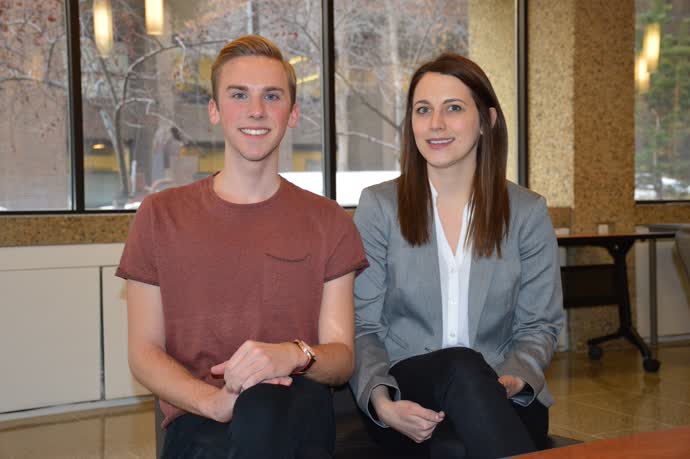
It's not often students co-author a peer-reviewed law journal article, but for third-year UAlberta Law students Sarah Denholm and Brandyn Rodgerson, that rare circumstance is a reality.
In September 2015, Denholm and Rodgerson were hired by Professor Peter Sankoff to research and co-write "An Unfair and Costly Burden: Assessing the Impact of Section 794(2) of the Criminal Code on the Criminal Justice System."
One year later, the draft was complete and sent to the Queen's Law Journal for peer review. A few months later Sankoff, Denholm and Rodgerson learned the good news: the article was accepted for publication.
Set to be published in April 2017, the paper explores the impact of section 794(2) of the Criminal Code of Canada, which states: "No exception, exemption, proviso, excuse or qualification prescribed by law is required to be set out or negatived, as the case may be, in an information."
The section is a reverse onus provision, essentially meaning that if, for example, someone was charged with failing to submit to a breathalyzer test without a reasonable excuse, the onus would be on the accused to prove, on a balance of probabilities, that the excuse is legitimate.
The article discusses the history of the section, and specifically the implications of R v Goleski, a 2015 Supreme Court of Canada decision ruling that the section should still be enforced. Sankoff, Denholm, and Rodgerson argue the opposite.
"The goal was to get the paper published," said Denholm, adding that she believes the experience made her a better writer.
Rodgerson, who will start his clerkship at the Alberta Court of Appeal this August and then article at Bennett Jones LLP, said the idea of learning more about academic writing appealed to him.
"I wanted to see the process of academic writing from the beginning, to being published," he said.
The paper required 5-10 hours of dedicated research and writing per week.
Though that may seem like a lot considering both students also had full class schedules, Denholm said she was more than happy to have the opportunity to learn from Sankoff.
"He treated us very much like co-writers, and made sure it was a learning experience for us," she said.
Rodgerson echoed her enthusiasm.
"Professor Sankoff really tried to teach us many different aspects of writing, from proper research, to exploring different issues," he said.
Sankoff's decision to pair Denholm and Rodgerson was not surprising. The two are good friends, having studied and co-hosted events together.
The chance to work hand-in-hand with a faculty member on a piece of research, just one more example of the opportunities available to students at UAlberta Law, was made possible when Sankoff applied for and received funding from the Faculty's Research and Professional Development Fund.
"Three years ago, I decided to try something new, hiring a student to co-write an article with me rather than simply have them research it," said Professor Sankoff. "The first go-round was so successful that two summers ago, I requested funding from the Faculty for the same purpose. Short term funding of this nature from the Faculty is really the only way for an initiative of this type to get going, and I personally think it's great to combine a teaching initiative/research opportunity to students with something that will also help further these students' careers."
"This experience has made me even more convinced to keep doing this in future years," he said. "I had a great time working with Sarah and Brandyn, and they both put so much into the project. It was really a 'win-win' experience."
Denholm, who plans to work in Vancouver for Fraser Litigation Group after graduation, said the writing process was collaborative, with weekly meetings to discuss the paper's progress and proofread each other's work.
Though the students have known about the article getting published for a few months, Denholm
said that the significance of the achievement is going to take longer to truly sink in.
"It still hasn't quite hit how rare and big an accomplishment this is," she said.
This story is the first in a series that will highlight students' work with faculty members. Keep checking back for more throughout the year.